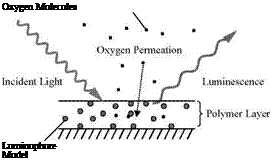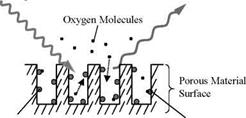Models for Porous Pressure Sensitive Paint
In the preceding section, the photophysical models for a conventional polymer PSP are discussed. Nevertheless, according to the work of Sakaue (1999), the photophysical models for a porous PSP or open PSP system are different. In general, pores in a porous PSP are macroscopic, which are much larger than the size of an oxygen molecule. Figure 2.2 shows schematically a comparison of a conventional polymer PSP with a porous PSP. In a conventional polymer PSP, as shown in Fig. 2.2(a), the oxygen molecules in the working gas permeate into a polymer binder layer and quench the luminescence. In contrast, as illustrated in Fig. 2.2(b), a porous PSP has a much larger open surface to which the luminophore molecules are directly applied; the oxygen molecules can directly quench the luminescence without having to permeate into a binder layer. Therefore, the use of a porous material as a binder for PSP offers two advantages. First, a porous PSP can achieve a very fast time response (in the order of microseconds) for unsteady PSP measurements; secondly, it makes PSP measurements possible at cryogenic temperatures at which oxygen diffusion is prevented through a conventional homogeneous polymer.

![]()
![]()
![]()
![]()
 (a)
(a)
(b)
 |
The oxygen quenching process in a porous PSP is different from that in a conventional polymer PSP. Figures 2.3(a) and (b) illustrate two scenarios of the oxygen quenching in a porous PSP; in both cases, a luminophore molecule is adsorbed on a porous surface opened to the working gas. In Fig. 2.3(a), a gaseous oxygen molecule collides to a luminophore molecule, resulting in the oxygen quenching; in this case, the oxygen quenching process is controlled by a collision between the gaseous oxygen molecule and luminophore molecule adsorbed on the surface. In other case, as illustrated in Fig. 2.3(b), an adsorbed oxygen molecule can cause quenching by diffusing to a luminophore molecule and hence the oxygen quenching process is related to adsorption and diffusion of the oxygen molecule into the luminophore molecule. Wolfgang and Gafney (1983) studied the oxygen quenching of tris(2,2′-bipyridyl)ruthenium (Ru(bpy)) on a porous Vycor glass and reported that Ru(bpy) was quenched by either a gaseous oxygen molecule colliding to the adsorbed Ru(bpy) or an adsorbed oxygen molecule.
Fig. 2.3. Oxygen quenching mechanisms for porous PSP: (a) Collision controlled model; (b) Adsorption controlled model. From Sakaue (1999)
Two photophysical models were developed by Sakaue (1999) to describe the oxygen quenching on a porous surface by considering the Eley-Rideal (ER) mechanism and Langmuir-Hinshelwood (LH) mechanism. The ER mechanism is a target annihilation reaction between a gaseous oxygen molecule and an adsorbed luminophore molecule; it is a collision-controlled reaction (Samuel et al. 1992). The LH mechanism, which is adsorption/surface-diffusion-controlled, is a reaction between an adsorbed oxygen molecule and an adsorbed luminophore molecule (Hinshelwood 1940). Samuel et al. (1992) studied the oxygen quenching of Ru(bpy) on a porous silica surface over a temperature range of 88-353 K and reported that at low temperatures the oxygen quenching was diffusion-controlled (the LH type). As temperature increased, the reaction remained the LH type in nature, but it was increasingly influenced by the target annihilation reaction (the
ER type). At higher temperatures, the reaction was no longer the LH type, which was dominated by the ER type reaction. In these cases, the rate constant kq for the oxygen quenching and the oxygen concentration [O2] were described in a different manner from that for a conventional polymer binder.











